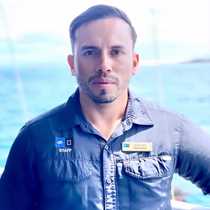Isabela & Fernandina Islands
Our day began as we assembled on deck before breakfast to look for whales. We did this as we entered the richest waters in the islands. The geological landscape that was on our port side was breathtaking. The tallest and most active volcanoes are in this part of the archipelago, so the whale watching activity was a good excuse to admire the steep cliffs, parasitic cones, and new lava flows which had made their way into the ocean. Before we anchored, we saw some petrels, shear waters, sea lions, a couple of whale spouts, and had our picture taken as we crossed the Equator. Later on, we had some surprises on our Zodiac ride, but the most unusual was finding several sunfish, which like to live in deep upwelling cold waters.
Today, we had a chance to snorkel with more than twenty green sea turtles. Some of them were sleeping while others were grazing the algae off the rocks. We were already feeling like the day was complete however, after lunch, most of us gathered for our second talk on geology given by Professor John Southard from MIT.
We prepared for our afternoon walk on Fernandina Island. The dry landing on this pristine island was just the beginning. Marine iguanas covered the ground to the point that we had to watch our step while walking. The mangroves provided a comfortable shade and before we knew it we had all photographed Galápagos hawks, Sally Lightfoot crabs, lava cactus and sea lions. The moon began to shine across our path as the sun began to set. The flightless cormorants dove as we drove back to the ship. The shadow of the earth was seen for several minutes over the volcanoes on Isabela Island. We realized that we had spent another day in paradise.




